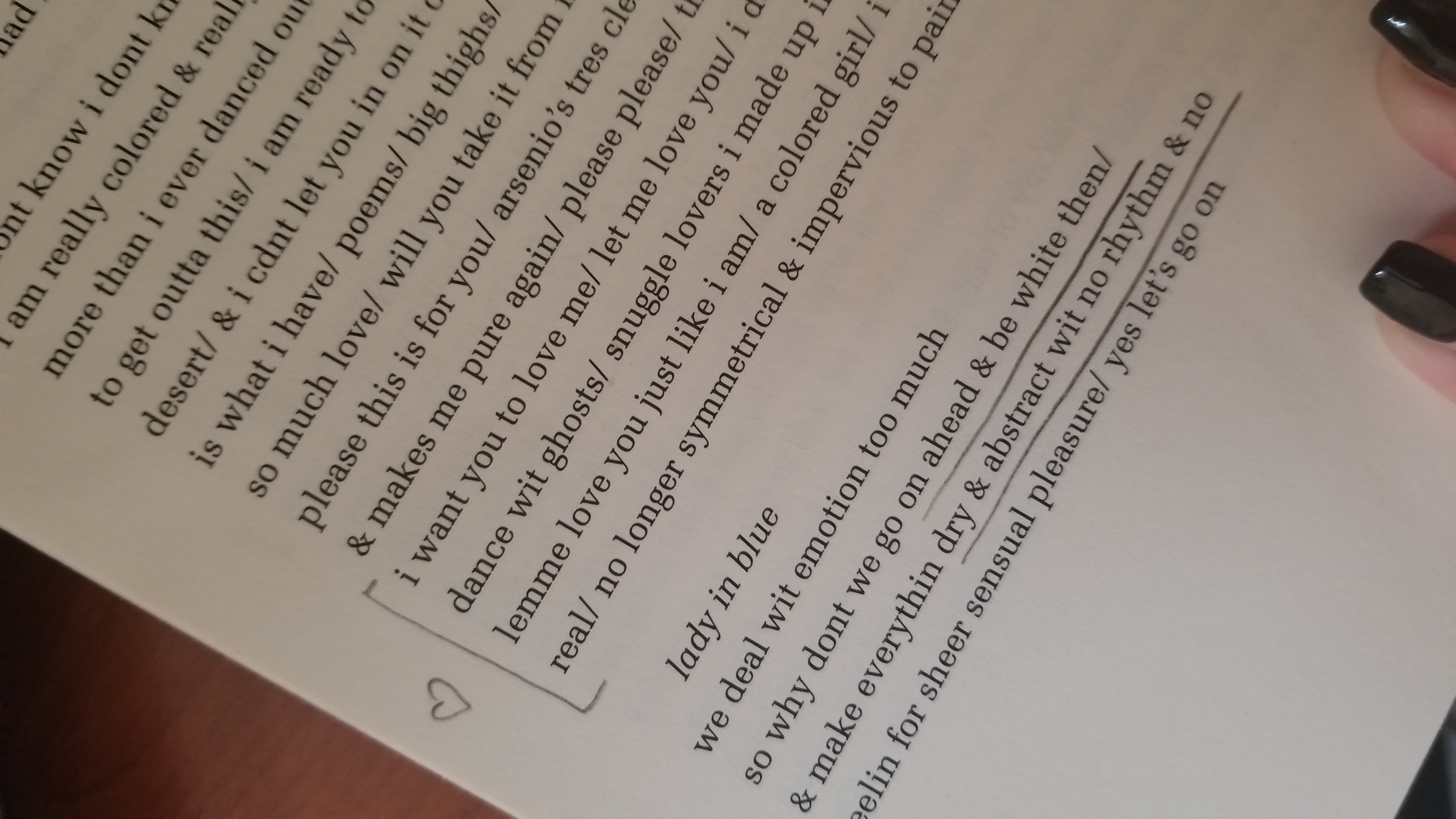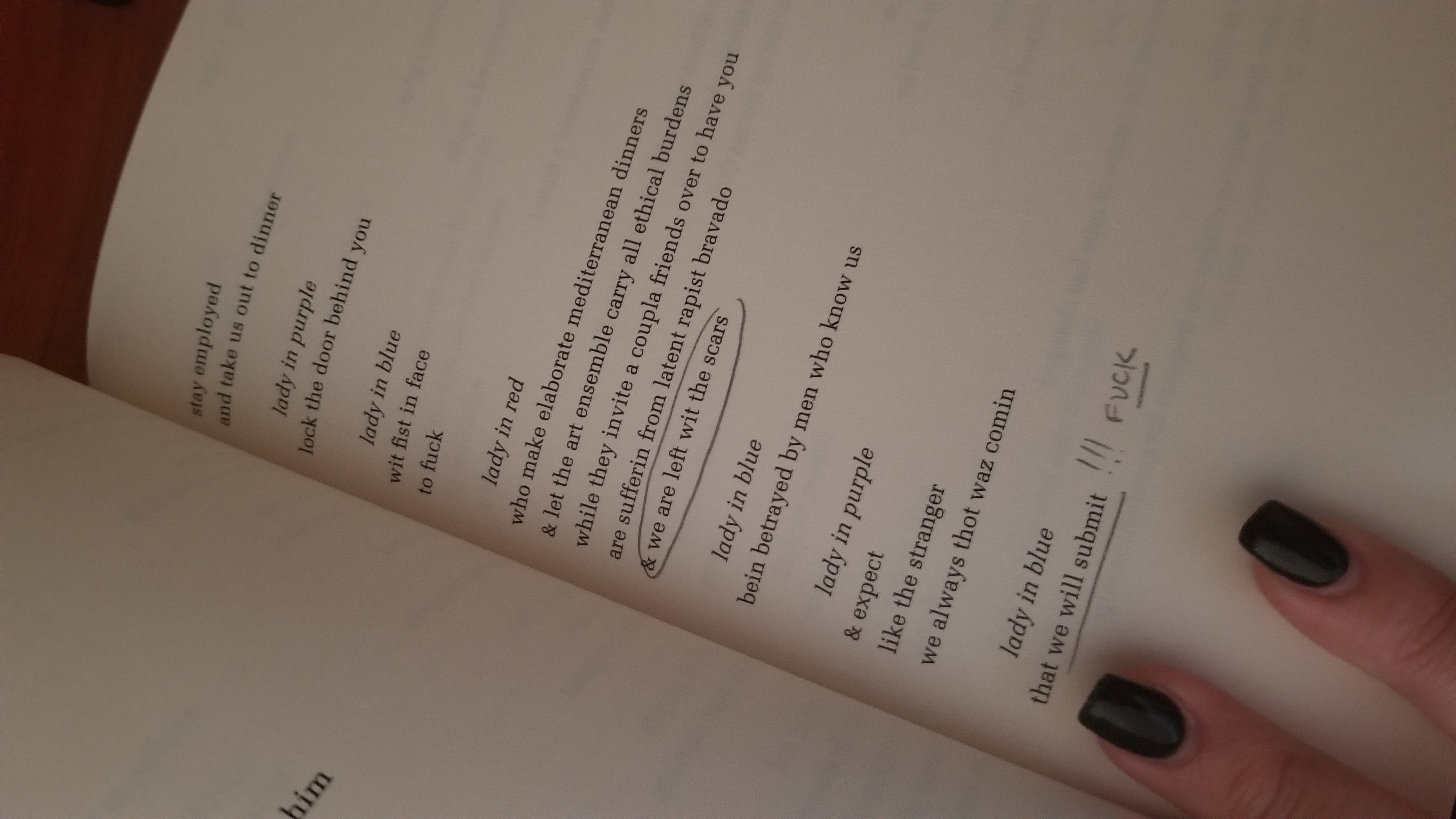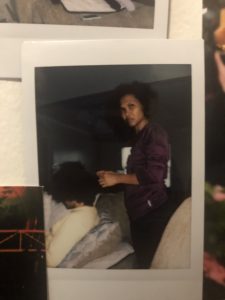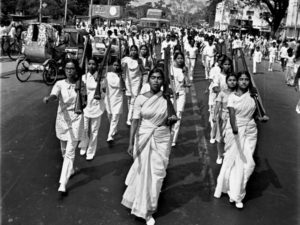The fiction that
most women have both husbands and
money is forever
with us
— Adrienne Rich, Of Woman Born, p. 247
Edited to be “read like Shange”
“Some problems we share as women, some we do not. You fear your children will grow up to join the patriarchy and testify against you; we fear our children will be dragged from a car and shot down in the street, and you will turn your backs on the reasons they are dying.”
— Audre Lorde, Sister Outsider, p. 119
Although Rich repeatedly speaks out against “the fiction” that privileged women represent an experience universal to all women (247), her essay contrasts with Ntozake Shange’s semi-autobiographical style in a significant way. Just as she grapples with both her womanhood and Blackness, Shange also confronts the privilege granted English speakers and American nationals like herself. However, Rich’s essay focuses on the oppression of women by men and women (but mostly by men), without granting the same deep interrogation to her own whiteness and the role of white women in perpetrating racist oppression.
Rich sympathetically engages with the burdensome expectations her mother faces as a white woman in the U.S. South to be “pure” like a “gardenia” (220). However, Rich does not necessarily explore how the white fragility granted more readily to women than men can be a privilege. Likewise, to convey an image of her mother, Rich, like her father, references the Botticelli Venus and Helen of Troy (219). These (often ahistorically whitewashed) Greek and Roman references dip into a cultural cache of sympathy for white beauty and innocence rooted in colonialism.
If oppression happens to women who do not look like Diane Kruger, it is not clear that their struggles take on equal importance in Rich’s essay. Her scattered references to women of color and women living outside of Europe and the U.S. are not framed in terms of solidarity, struggle, and family like in Shange’s poem Bocas — “i have a daughter/ mozambique / i have a son/ angola” (Daughter’s Geography, 21). Instead, she presents them as passive victims of backwards regimes, such as the blanket statement that Chinese foot-binding is an “affliction” and a “mutilat[ion]” (243).
The hubris, as Gayatri Spivak has put it, that “white men [need to] save brown women from brown men” has been used by colonial governments and continues to be used by neocolonial governments as a justification for violent intervention and conquest (see, for instance, the U.S. invasion in Afghanistan), as Dorothy Ko, Lila Abu-Lughod and Saba Mahmood have pointed out. In her reflection on sati in “Can the Subaltern Speak?” Spivak suggests that it is very suspect when women wish to fight for women’s rights in a society they do not come from without making a lifetime commitment to becoming fluent in the epistemologies, languages, and histories of that society.
Quoting the Upanishads and ancient Egyptian hymns out of context without understanding the original or explaining who did the translating and why, leads to a loss of opportunity to truly appreciate the dimensions of women’s struggles and everyday experiences in these societies (226). As Spivak points out in “The Politics of Translation,” “if we were thinking of translating […] Emily Dickinson, the standard for the translator could not be ‘anyone who can conduct a conversation in the language of the original (in this case English)’” (188).
Rich’s detour to Atwood’s novel about a white woman who, as white women do, finds herself by “going back to nature” in a Rousseau-esque, George-Catlin-esque appropriation of the culture, skills, knowledge systems, and survival strategies of the Creek nation in Canada is particularly troubling because she does not bring up white women’s role in genocide and land theft from First Nations; nor does she acknowledge the violence of the anthropological technology of the “Indian photographs” (240-241). For a useful critique, see contemporary artist Kent Monkman’s work (he has Scots-Irish and Creek ancestry).
Moreover, Rich’s quotes from ancient India, ancient Egypt, ancient China, and ancient Greece are all actually about a tiny elite of rich women, and should not be taken to represent all women in that time period. Rich mourns that women have been historically saddled with the difficulties of raising children and being full-time “homemakers” (236). She describes the specter of “women going mad ‘for want of something to do’” (229). In contrast, Shange is far more concerned with the history of Black American women, who have always had to fight for the right to mother their children and make time to do so amidst enormous work demands.
This history is rooted in from the separation of mothers from children under American white supremacist slavery, a system in which women were an equal or majority proportion of field laborers outdoors, in addition to maintaining food and households in their communities and kinship networks. The experiences of women who worked in white women’s households trouble the distinctions between home and workplace. Aside from the feeling of being trapped in the legal institution of marriage, enslaved women were struggling to have their family relations and marriages, as well as their rights as mothers, be legally and socially recognized and respected at all; and to this day Black American women struggle to live peacefully with their partners without racist government intervention tearing them apart, for instance through police brutality and mass incarceration.
This is a far cry from the enormous privilege of the “pattern” of “close” and “long-lasting” bonds between mothers and daughters in intimate domestic spheres that Rich attributes as “characteristic of the period” of “the 1760s to the 1880s” (233). She does not address the experiences of millions of enslaved women, thus implying that there is something un-“characteristic” about their struggles. Here she loses an opportunity to interrogate her own white privilege as a woman who identifies with the boredom of the household and child care, but free of work demands due to perceived purity and fragility.
On 225, Rich suggests that institutional motherhood incompatible with wage-earning (or more generally, outside-the-house-working) motherhood: “Institutional motherhood makes no provision for the wage-earning mother.” As proof she draws on the constraints given white women and elite women historically. This contrasts with Shange’s work, which is deeply focused on the tangles between women’s unpaid labor as exploitation and their labors of love, and which is invested in contributing to the restoration and new creation of destroyed kinship networks.
Through the lens of Shange’s work, it may be worth asking whether institutional motherhood is, for most women, anything but incompatible with being mother-workers who are expected to maintain households, provide sexual labors, and replenish the labor force by raising children, all unpaid, at the same time as working outside the house, for the maintenance of other families’ households, and/or in paid work.
For instance, as Dorothy Ko has pointed out in Cinderella’s Sisters, most ancient Chinese women were peasants who did not undergo foot-binding, in large part because they had to be able to work. Part of what made foot-binding a status symbol was that it meant the woman with “delicate,” “small” feet had servants with “ugly,” “big” feet who waited on her and did her housework for her. In the institution of slavery, as Saidiya Hartman has pointed out, the doctrine of partus sequitur ventrem conscripted enslaved women’s wombs as factories to reproduce an unpaid labor force.
For most women today, it remains true that we are expected to raise healthy children and bring pregnancies to term while at the same time working around the clock. What would it look like if Rich’s analysis explored the ways in which institutional motherhood is built around the working mother, with rare exemptions for a small elite who thus have a deep personal stake in maintaining patriarchy, racism, and class oppression?







